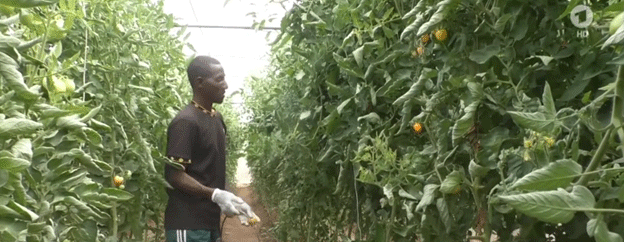Somalia’s Greenhouse Revolution
Somalia, an East African country often plagued by drought, is currently enduring one of its most severe dry spells in decades. With rainfall virtually nonexistent for over a month, traditional farming methods have become increasingly untenable. Amidst this crisis, young farmers like Abdirahman Sabriye are pioneering a solution: greenhouse farming.
On the outskirts of Mogadishu, Abdirahman has established greenhouses to cultivate tomatoes. Using water-efficient drip irrigation, he harvests approximately 400 kilograms of tomatoes every two days. These are picked green to ripen later, ensuring a steady supply of fresh produce. “In greenhouses, we can harvest far more than on open fields,” he says, emphasizing the importance of this innovation in addressing local food shortages.
The Advantages of Greenhouse Farming
Greenhouses offer significant benefits in drought-affected regions like Somalia:
- Water Efficiency: With less evaporation and precise drip irrigation, greenhouses drastically reduce water consumption—a critical factor in water-scarce areas.
- Year-Round Harvesting: Unlike traditional farming reliant on seasonal rains, greenhouse cultivation enables continuous production.
- Higher Yields: Controlled environments minimize pests and diseases, allowing for higher crop outputs.
Abdirahman’s project, funded by family contributions, highlights the potential for scalable solutions in regions where agriculture is vital for survival. By tapping into groundwater instead of relying on erratic rainfall, his greenhouses ensure a reliable water source.
Drought’s Impact on Agriculture
Somalia’s current drought has devastated the livelihoods of millions, with the United Nations estimating that over 7 million people are facing acute food insecurity. Traditional farming methods, dependent on rain, cannot meet the growing demand for food. Greenhouses, though requiring initial investment, present a sustainable alternative.
According to the Food and Agriculture Organization (FAO), water-efficient practices like drip irrigation can reduce water usage by up to 70% compared to traditional methods. Combined with greenhouses, this can significantly bolster food production in drought-prone areas.
The Road Ahead
For greenhouse farming to become widespread in Somalia, access to funding, education, and infrastructure must improve. Projects like Abdirahman’s serve as models for community-driven solutions, but broader government and international support are necessary to scale these efforts effectively.
In the fight against hunger and climate challenges, greenhouse farming offers a beacon of hope. By utilizing water-efficient technologies and controlled environments, young farmers like Abdirahman are not only combating the immediate effects of drought but also laying the foundation for a more resilient agricultural future in Somalia.











